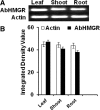In silico characterization and differential expression pattern analysis of conserved HMG CoA reductase domain isolated from Aconitum balfourii Stapf
- PMID: 28330159
- PMCID: PMC4781813
- DOI: 10.1007/s13205-016-0405-y
In silico characterization and differential expression pattern analysis of conserved HMG CoA reductase domain isolated from Aconitum balfourii Stapf
Abstract
The 3-hydroxy-3-methyl glutaryl CoA reductase (HMGR) is the key enzyme of mevalonate pathway in plants. A partial genomic DNA fragment encoding HMGR conserved domain (denoted as AbHMGR) is isolated from Aconitum balfourii Stapf. It comprises 871 bp encoding 290 amino acids. In silico analysis reveals that it had extensive similarities to other plant HMGR gene. Domain analysis of AbHMGR showed two highly conserved NADPH and HMG CoA domains. Docking study predicted inhibitor, substrate and cofactor binding sites in the protein. Expression analysis revealed that AbHMGR is similarly expressed in all tested tissues with differential pattern. The highest expression was found in leaf tissue. However, fold expression in root and shoot tissue was almost similar. Enzyme activity of HMGR was found to be much higher in leaf tissue as compared to other tissues. The highest aconitine content (0.015 %) was obtained in root tissues. Our data laid a foundation for further investigation of HMGR role in Aconitum balfourii.
Keywords: 3-Hydroxy-3-methyl glutaryl-CoA coenzyme A reductase; Aconitine; Expression profiling; HMGR; Mevalonate pathway.
Conflict of interest statement
We wish to confirm that there are no known conflicts of interest associated with this publication and there has been no significant financial support for this work that could have influenced its outcome.
Figures





Similar articles
-
Isolation, characterization and in silico analysis of 3-Hydroxy-3-methylglutaryl-coenzyme A reductase (HMGR) gene from Andrographis paniculata (Burm. f) Nees.Mol Biol Rep. 2020 Jan;47(1):639-654. doi: 10.1007/s11033-019-05172-0. Epub 2019 Nov 28. Mol Biol Rep. 2020. PMID: 31781917
-
Structural Features and Domain Movements Controlling Substrate Binding and Cofactor Specificity in Class II HMG-CoA Reductase.Biochemistry. 2018 Feb 6;57(5):654-662. doi: 10.1021/acs.biochem.7b00999. Epub 2017 Dec 21. Biochemistry. 2018. PMID: 29224355 Free PMC article.
-
Bioactivity guided fractionation and hypolipidemic property of a novel HMG-CoA reductase inhibitor from Ficus virens Ait.Lipids Health Dis. 2015 Mar 4;14:15. doi: 10.1186/s12944-015-0013-6. Lipids Health Dis. 2015. PMID: 25884722 Free PMC article.
-
The structure of the catalytic portion of human HMG-CoA reductase.Biochim Biophys Acta. 2000 Dec 15;1529(1-3):9-18. doi: 10.1016/s1388-1981(00)00134-7. Biochim Biophys Acta. 2000. PMID: 11111074 Review.
-
Regulation of HMG-CoA reductase activity in plants.J Lipid Res. 1994 Jul;35(7):1133-40. J Lipid Res. 1994. PMID: 7964176 Review.
Cited by
-
Isolation, characterization and in silico analysis of 3-Hydroxy-3-methylglutaryl-coenzyme A reductase (HMGR) gene from Andrographis paniculata (Burm. f) Nees.Mol Biol Rep. 2020 Jan;47(1):639-654. doi: 10.1007/s11033-019-05172-0. Epub 2019 Nov 28. Mol Biol Rep. 2020. PMID: 31781917
-
In silico characterization and differential expression analysis of 1-deoxy-d-xylulose-5-phosphate reductoisomerase (DXR) of Centella asiatica.3 Biotech. 2021 Apr;11(4):184. doi: 10.1007/s13205-021-02723-w. Epub 2021 Mar 22. 3 Biotech. 2021. PMID: 33927975 Free PMC article.
-
An in - silico perspective on the role of methylation-related genes in wheat - Fusarium graminearum interaction.3 Biotech. 2025 Jan;15(1):12. doi: 10.1007/s13205-024-04179-0. Epub 2024 Dec 16. 3 Biotech. 2025. PMID: 39698303
References
LinkOut - more resources
Full Text Sources
Other Literature Sources

